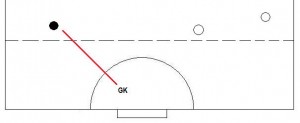The rules have been changed again and the free hit rule has been adapted to allow a player to pass the ball to themselves and then make a pass, in comparison to smashing it straight away (this includes goalkeepers). This new self-pass therefore allows the goalkeeper to take free hits. However, you should be thoughtful about how and when you use the move, otherwise you could end up in a spot of bother with the opposition bearing down on you looking for an easy goal. Working on technique and looking to use it wisely is a good idea to helping your team; furthering their options and freeing up a player who would normally take the free hit.
Restarting play
The self-pass is a good way of quickly restarting play from a 16. By restarting the play quickly, rather than waiting around for a defender to wait and look for options, you speed up the pace; giving your team the advantage of surprise and speed, which can lead to a goal if the team takes hold of the situation and pushes up the field. By bypassing having a defender take the free hit you save time, whilst also freeing up another player to push forward on the attack (or provide extra defence; defending back if needs be).
Technique
In terms of technique, the self-pass is essentially a simple stick and ball manoeuvre; using the stick and then kicking away with the kicker. You can set up the pass with your stick, placing the ball in front of you to get a good angle on the kick. You need to pass the ball to yourself, so knock the ball back to yourself with the stick. Having passed it to yourself, you can then kick it to a nearby defender. Make sure the pass is accurate, so that it reaches the intended recipient properly.
Goalkeeper making the free hit self-pass to an open defender.
A more difficult skill is to use the self-pass option to ‘throw’ an aerial, like a soccer (football) goalkeeper would do at goal kicks. Simon Mason is the only goalkeeper I know of that can do this successfully; having seen him practising it and going beyond the half way line (to the three quarter mark). As the rules of a ‘dangerous ball’ still apply to an aerial kicked by the goalkeeper, it is a very risky move to try and pull off, unless you have the skill and accuracy to do so. Therefore I don’t recommend you try it, even if it’s fun at the training ground!
When to
The self-pass can be used properly when looking to restart the play “off the bat” without much danger of the opposition intercepting the pass. As long as there is a defender to cover a roaming opposition player and there are no opposing players (or little danger of intercepting the pass) posing a risk to you making a pass, then you should be able to make the pass. I have seen it used like this in a National Premier league game here in England; the goalkeeper quickly restarting play within the D by kicking the ball to a team mate after a shot outside the D (where a 16 is automatically given as a result).
Be careful
Ultimately, it is a great move when used correctly, but can go horribly wrong if not. You need to be careful and wise about when you use it; being aware of present threats, otherwise you could end up gifting a goal to the opposition team.


i dont think this to be very useful, with indoor hockey this used to be a very handy way of freeing up play, but in the feild it puts up too much risk, and seen as a defender can just take the free hit and walk with the ball there is no need for the keeper to take the hit.
still good piece
Depends on your team and the way you “play” in goal, I guess.
I try to play more like a soccer goalie (standing ~2 meters from the line of the D as my ready stance) rather than an icehockey goalie (staying close to the goal), just to put it metaphorically. So if the other team makes a mistake I’m normally close enough to the ball to take the free hit.
Personally I’d have a look around, checking if there’s one of my team mates in a reasonable distance. If yes, I’d sure take the free hit to get the game running again quickly (and maybe try it Simon Mason style…^^). If no, well, then I’d just wait for one of my defenders to take the free hit.
I have done this all the time, The best time to do it is when the other team hit the ball up and is goes for a 16, with no one in the attack its a great way to get your team going again and putting pressure straight back on the other team, as long as your careful and give yourself lots of time is great.
Hi there,
Just a quick question in relation to the picture. The copyright of the irishhockeyphotographers of which I am an administrator. Just checking you have cleared it with the photographer for reproduction on this site ?
Regards
Stephen Findlater
Hi all,
Just wondering if you would be able to tell me which body armour the keeper is using in the picture with padded part right down to his elbow, but then stops ????
Thanks